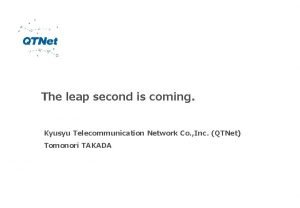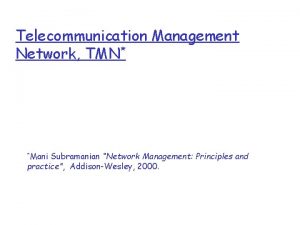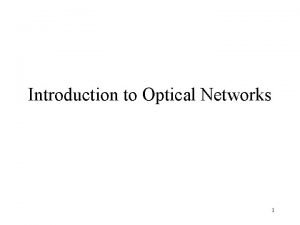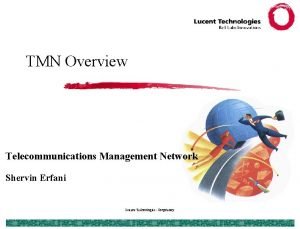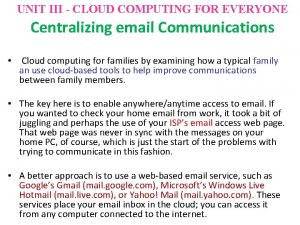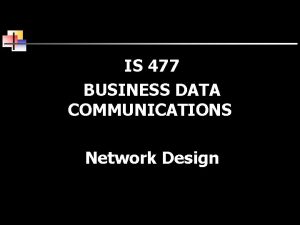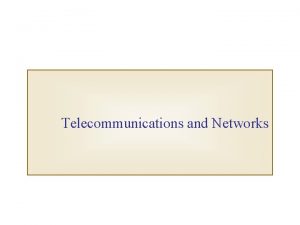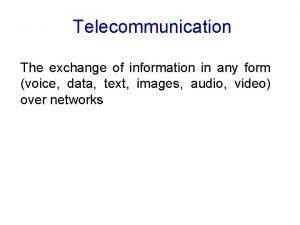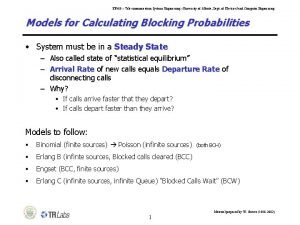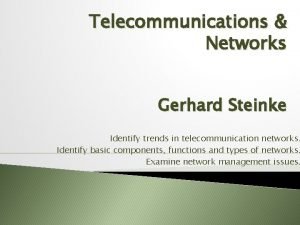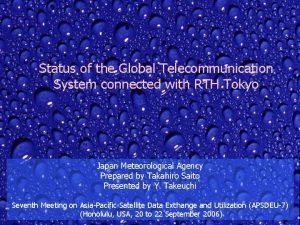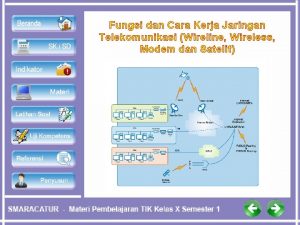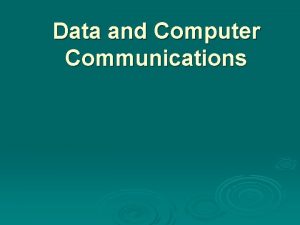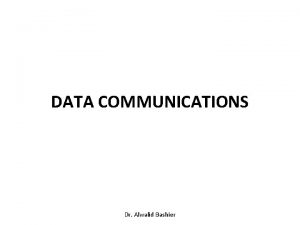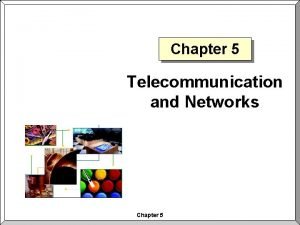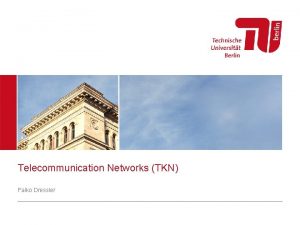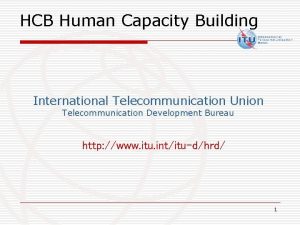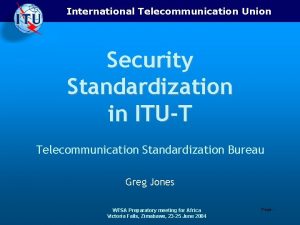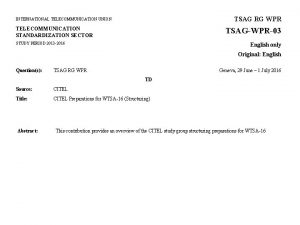Network Computing DATA COMMUNICATIONS The term telecommunication means






















- Slides: 22

Network Computing

DATA COMMUNICATIONS The term telecommunication means communication at a distance. The word data refers to information presented in whatever form is agreed upon by the parties creating and using the data. Data communications are the exchange of data between two devices via some form of transmission medium such as a wire cable.

Five components of data communication

Data flow (simplex, half-duplex, and fullduplex

NETWORKS A network is a set of devices (often referred to as nodes) connected by communication links. A node can be a computer, printer, or any other device capable of sending and/or receiving data generated by other nodes on the network. Two devices are in network if a process in one device is able to exchange information with a process in another device. A network is consist of group of computer systems, servers, networking devices are linked together to share resources

TYPES OF NETWORKS Computer Networks fall into three classes regarding the size, distance and the structure namely: LAN (Local Area Network), MAN (Metropolitan Area Network), WAN (Wide Area Network)

LAN (Local Area Network) A LAN is a privately owned computer network covering a small Networks geographical area, like a home, office, or groups of buildings e. g. a school Network. It is used to connect the computers and other network devices so that the devices can communicate with each other to share the resources. The size of LAN is usually small. The various devices in LAN are connected to central devices called Hub or Switch using a cable.

MAN (Metropolitan Area Networks) MAN is larger than a local area network and as its name implies, covers the area of a single city. MANs rarely extend beyond 100 KM and frequently comprise a combination of different hardware and transmission media. It can be single network such as a cable TV network, or it is a means of connecting a number of LANs into a larger network so that resources can be shared LAN to LAN as well as device to device. MANs are usually owned by large organizations to interconnect its various branches across a city.

MAN

WAN (Wide Area Networks) WAN is a telecommunication network. It is simply a LAN of LANs or Network of Networks. WANs connect LANs that may be on opposite sides of a building, across the country or around the world. WANS are characterized by the slowest data communication rates and the largest distances. Computers connected to a Wide Area Networks are often connected through public networks, such as the telephone system. They can also be connected through leased lines or satellites. The largest WAN in existence is the Internet.

WAN

Network topology is the arrangement of the elements of a communication network.

Mesh Topology 1. 13

Star Topology 1. 14

Bus Topology 1. 15

Ring Topology 1. 16

THE INTERNET The Internet, sometimes called simply "the Net, " is a worldwide system of computer networks. It is a network of networks in which users at any one computer can, if they have permission, get information from any other computer. The Internet has revolutionized many aspects of our daily lives. It has affected the way we do business as well as the way we spend our leisure time. The Internet is a communication system that has brought a wealth of information to our fingertips and organized it for our use. It was conceived by the Advanced Research Projects Agency (ARPA) of the U. S. government in 1969 and was first known as the ARPANet.

THE INTERNET Physically, the Internet uses a portion of the total resources of the currently existing public telecommunication networks. Technically, what distinguishes the Internet is its use of a set of protocols called Transmission Control Protocol/Internet Protocol (TCP/IP).

Uses of the Internet In general, the Internet can be used to communicate across large or small distances, share information from any place in the world and access information or answers to almost any question in moments. Some specific examples of how the Internet is used include: E-mail and other forms of communication, such Internet Relay Chat (IRC), Internet telephony, instant messaging, video conferencing and social media; education and self-improvement through access to online degree programs, courses and workshops and Searching for jobs -- both the employer and applicant use the Internet to post open positions, apply for jobs and recruit individuals found on social networking sites like Linked. In.

Security and the Internet Large amounts of information, both public and private, is collected across the Internet, opening users up to the risk of data breaches and other security threats. Hackers and crackers can break into networks and systems and steal information such as login information or bank and credit card account records. Some steps that can be taken to protect online privacy include: Installing antivirus and antimalware Creating difficult, varied passwords that are impossible to guess. Making all social media accounts private. Deactivating autofill. Turning off the device's GPS. Updating cookies so an alert is sent anytime a cookie is installed. Logging out of accounts instead of just closing the tab or window. Using caution with spam emails and never opening or downloading content from unknown sources. Using caution when accessing public Wi-Fi or hotspots.

The World Wide Web (WWW) The Web, is an information system where documents and other web resources are identified by Uniform Resource Locators (URLs, such as https: //www. example. com/) They may be interlinked by hypertext, and are accessible over the Internet. The resources of the WWW may be accessed by users by a software application called a web browser. Tim Berners-Lee invented the World Wide Web in 1989 Difference between Internet and www?

Network Applications Examples of Network Applications E-mail The Web Instant Messaging Remote login File sharing File Transfer between two accounts on two computers (FTP) Multi-user networked games Streaming stored video clips Internet Phone Real time video conferencing
 Means of telecommunication
Means of telecommunication Kyushu telecommunication network co.,inc.
Kyushu telecommunication network co.,inc. Tmn function block: a) osf b) mf c) wsfe d) nef e) qaf
Tmn function block: a) osf b) mf c) wsfe d) nef e) qaf In a telecommunications network architecture, a protocol is
In a telecommunications network architecture, a protocol is Difference lan wan
Difference lan wan Shervin taghavi
Shervin taghavi Network management principles and practice
Network management principles and practice Network centric computing and network centric content
Network centric computing and network centric content Centralizing email communication in cloud computing
Centralizing email communication in cloud computing Conventional computing and intelligent computing
Conventional computing and intelligent computing Communications network design
Communications network design Chapter 3 network protocols and communications
Chapter 3 network protocols and communications Telecommunications project management
Telecommunications project management Objectives of telecommunication
Objectives of telecommunication Telecommunication information
Telecommunication information Telecommunication
Telecommunication Society of worldwide interbank financial telecommunication
Society of worldwide interbank financial telecommunication Telecommunication
Telecommunication Global telecommunication system
Global telecommunication system Trends in telecommunication
Trends in telecommunication Global telecommunication system
Global telecommunication system Itu world telecommunication indicators database
Itu world telecommunication indicators database Jelaskan jaringan telekomunikasi wireless
Jelaskan jaringan telekomunikasi wireless

